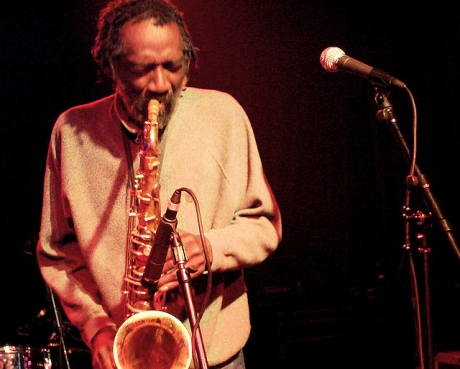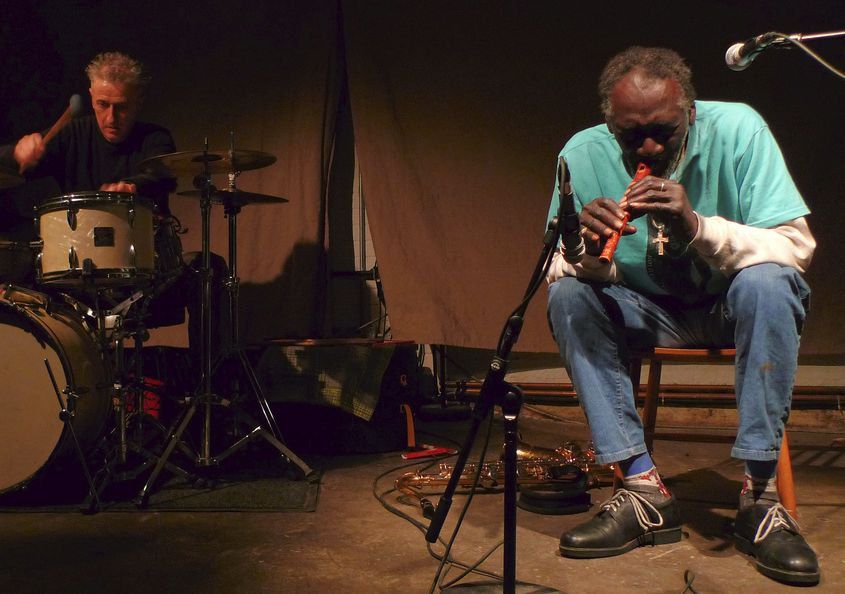Perhaps it’s too simple to call a musician like Arthur Doyle a “revenant.” The term has recently come into use describing the spectral power and elegiac traces of folk-blues musicians and prewar gospel, not to mention free-jazz saxophonist Albert Ayler’s conjuring of “Ghosts,” “Spirits,” “Witches & Devils,” and other figures from beyond. There is a feeling that, dead or not, these artists brought shamanic power and otherworldliness to their music, separating it from secular ramblers or modernist technicians. In the case of free-jazz and improvised music, too much credence is often given to the “spiritual” and the “mystery,” which isn’t to say that creativity can’t be in service of spiritual concerns, but that it can get in the way of artistic innovation and rare vision. The same goes for reliance on “outsider” approaches — namely, pegging an artist as “outside” often results from too little understanding of what terms like “inside” and “outside” really mean.
All this being said, it would be unfair not to acknowledge the outsiderness of reedman, pianist, vocalist, and composer Arthur Doyle (June 26, 1944 - January 25, 2014), who truly operated within a specific vision well apart from the free-jazz mainstream. The following is an abbreviated biography of Doyle’s musical career, one that reflects both his unique vision and his relentlessly challenging work in the underground.
Born in Birmingham, Alabama, Doyle was the second of five children and from a young age was attracted to the sounds of Louis Armstrong, Duke Ellington, soul, and doo-wop artists. As he told historian Roy Morris in a November 1994 interview (published in the December 1995 issue of Cadence Magazine), “There was a lot of jazz in Birmingham that I got hip to later. There was this lady named Thereline that had a few thousand records of all the jazz artists. She cut hair on Sunday. I would go to her house around nine o’clock and stay to around six or seven o’clock, getting my hair cut and listening to records,” including those by saxophonists like Sonny Rollins and John Coltrane. Doyle also notes that, with shades of things to come, “when I was a kid, I wanted to write [Armstrong] and ask him to send me a horn so I could play and sing like him.”
Originally an alto saxophonist, Doyle gigged around Birmingham as a teenager with trumpeter Walter Miller (also an associate of the Magic City’s own Ellingtonian figure, Sun Ra) and saxophonist Otto Ford, playing in blues and R&B groups. After studying at Tennessee State College in Nashville, he continued the road-soldier lifestyle. Other associates at this impressionable age included trumpeter Louis Smith and the soul singer Gladys Knight, with whom he sat in while a college student. As he told Cadence, “There was a lot of jazz clubs there and jazz musicians around. One of the musicians was from Detroit and founded a band. It had people in it like [fellow Birmingham bassist] Bob Reid, [trumpeter] Frank Walton and myself… We was very revolutionary and took a lot of gigs in the Black movement and played a lot of clubs playing free jazz.” Doyle went to Detroit in the mid-1960s for a brief period and worked with hard bop trumpeter Charles Moore; not fitting into that environment, he returned to Nashville and traveled with an R&B group that dropped him off on the East Coast.
Arthur Doyle made the otherworldly material.

Doyle’s approach to the saxophone may have more to do with gospel soul and his R&B roots than anything bop-related, which is why it was so odd when he performed tunes like “Nature Boy” or “Confirmation” as part of solo recitals. His tenor sound was raw and unpolished, charged with vocal glossolalia arrived at by using a soft reed and singing through the horn. Doyle’s parents were politically active in Birmingham during the 1960s, and the charge of energy music was certainly part of Doyle’s voice. As he told Morris, “I feel it all went hand in hand. The free jazz movement and people wanting to be free… The only time I got caught up in the Vietnam War was not to go, because I feel as my fight was with trying to free Black people… All of this had an effect on me as a man and musician. The children killed in the church in Alabama and the killing of civil rights workers [like] Dr. King and Malcolm X.”
When Doyle moved to New York in 1968, he quickly became friends with innovators of the new music, including reedman Pharoah Sanders (they were introduced by Leon Thomas’ brother Shiene) and guitarist Sonny Sharrock, and worked briefly with Sun Ra. As a sideman, Doyle’s first appearance on record was with alto saxophonist Noah Howard, the brightly excoriating LP Black Ark (Polydor, 1968). Sleeve-note writer Mal Dean characterizes Doyle’s playing as being “propelled throughout by an almost incoherent rage, a chaotic and murderous sound.” Perhaps in revolutionary times, such terminology is necessary, but it paints a narrow worldview of this music that, while charged, was not merely angry. Doyle also worked with trumpeter-composer Bill Dixon intermittently beginning in 1968, though none of this work was commercially released.
Another early New York associate was the Queens-based drummer Milford Graves, whose Afro-Cuban-rooted brand of free music was especially high octane and who treated reed and brass players like auxiliary percussionists in a modern, collectively improvised drum choir. Apparently the two met in 1968, and Graves encouraged the saxophonist to discard any vestiges of bebop or traditional “jazz” tropes, bringing out his natural proclivity to pure sound. Graves’ 1970s ensemble featured Doyle alongside a rotating cast, including saxophonists Frank Lowe, Hugh Glover, and Joe Rigby; trumpeter Arthur Williams; and percussionist Raleigh Sahumba, in which swells of fractured sound buoyed a frantically paced but utterly clean panoply of time signatures. The only album released from this group was the 1976 IPS LP Bäbi Music, a trio of Graves, Glover, and Doyle, but it’s blisteringly indicative of what they did.
In 1978, the reedman released his first LP as a leader, Alabama Feeling, which featured then-frequent associates, trombonist Charles Stephens (a Sun Ra alum, also from Birmingham) and drummer Rashid Sinan, along with Sinan’s drum student Bruce Moore and electric bassist Richard Williams, for a program of improvisations recorded live at Charles Tyler’s loft The Brook (Doyle rented the space for the concert recording) and released on Tyler’s Ak-Ba label. Although it may at first seem like an utterly white-hot mass of sound, Alabama Feeling ebbs and flows with a natural, conversational quality, in which soupy funk and charged energy playing are equal partners. Doyle’s unaccompanied salvo, “Something for Caserlo, Larry and Irma,” is the second cut on the first side, a hoarsely real and gutsy piece of insight into Doyle’s language. Far from slapdash, it’s concentrated and declaratory while also being incredibly soulful. Raw and quite fuzz-laden in fidelity, Alabama Feeling shares with such releases as Boston saxophonist Abdul Hannan’s Awareness (The Third World, 1972), New York collective The Freestyle Band (Adeyeme, 1984), and Bay Area outfit the Pygmy Unit (Signals from Earth, self-released, 1974) an almost ethnographically field-recorded vibe, as though energy music and free improvisation could be documented as an expressionistic ritual. Of course, this fact necessarily spotlights the otherness with which free music can be unfairly saddled, but the works’ specificity may trump their alienness.
Doyle’s songs occupy a special place outside any pantheon, yet their realness is shocking and captivating.
It was also in the late 1970s that Doyle began working with guitarist Rudolph Grey; associated with No Wave, Grey had been seeking an opportunity to hear and hopefully work with Doyle after reading a review of the Black Ark LP and seeing the concert that produced BäBi Music. Following the dissolution of punk unit Red Transistor, Grey formed a new outfit that allowed an inspired collaboration with old-guard free-jazz drummer Beaver Harris (who had worked with Ayler, Archie Shepp, Roswell Rudd, and Marion Brown) and Doyle, which brought long-form free improvisation to such hallowed Downtown New York spots as Hurrah’s and Max’s Kansas City. In some instances without a drummer, Doyle and Grey worked as a high-volume and certifiably unhinged duo, with an excerpt of one such performance appearing on Grey’s Transfixed (New Alliance, 1988), as well as on the archival seven-inch Ghosts II (Foreign Frequency, 2009).
Despite work across contexts as diverse as free improvisation and No Wave, Doyle struggled with anxiety issues and relocated upstate to Endicott, New York in the latter half of the 1970s, where he found work as a counselor. In 1981, Doyle went to Paris, and a year later, he attempted to settle permanently overseas (indeed, he quickly began playing with multi-instrumentalist and orchestral composer Alan Sliva), but he was accused of rape and, though eventually pardoned, five years in the French prisons left a lasting imprint on the psyche of this fragile individualist. During his stay in prison, Doyle wrote over 150 songs that became the Arthur Doyle Songbook — nursery rhyme-like folk tunes and obsessively-rendered, deceptively simple lyrics in homage to fallen heroes and family figures that, in performance, would be interspersed with saxophone squall and microtonal flute twitter. In 1993, Doyle began releasing his music on small labels that had sprung up in his absence, such as Grey’s Audible Hiss and the Thurston Moore/Byron Coley imprint Ecstatic Peace!, and his art found a new and hungry audience. In fact, his work was more frequently documented in the last 20 years of his life than during the loft-jazz heyday of the late 60s and mid-70s.
In boom box-recorded renditions on such albums as Plays and Sings from the Songbook Volume One (Audible Hiss, 1995), The Songwriter (Ecstatic Peace!, 1995), and Do the Breakdown (Ain Soph, 1997), there are views of an artistic figure whose specificity plays to the universal, and that’s part of what makes Doyle’s solo work so unique. It isn’t polished or pretty, and its delicate, personal expression can be a lot to bear — even for someone weaned on the avant-garde. Doyle’s songs occupy a special place outside any pantheon, yet their realness is shocking and captivating. He began performing again in 1992, and Grey was the catalyst for bringing him to CBGB’s that year. As the saxophonist told Morris, “The reaction was very good when I came back to the city to play with Rudolph. People showed up and wanted me to sign my record. And the place was packed with people.” That was the vibe when this writer saw Doyle solo at Minneapolis’ Freedom From/De Stijl Festival in 2003, curated by Freedom From’s Matthew St-Germain and De Stijl’s Clint Simonson. From the late 1990s onward, Doyle also played somewhat regularly in ensemble configurations, blending the go-for-broke free improvisation of yore with his folk-song structures and collaborating with players like drummers Sunny Murray, Hamid Drake, and Sabu Toyozumi; Les Rallizes Denudes guitarist Takashi Mituzani; and the synthesizer and sampler-heavy group The Arthur Doyle Electro-Acoustic Ensemble.
Spending the last several years in his hometown of Birmingham, Doyle’s recorded output became less frequent, but his mark on creative music had become secure. His music was certainly brought from a well of tough experience and reflected joy and sorrow in a tangible way, going well beyond the free music tradition. Arthur Doyle made the otherworldly material, and it’s unfortunate that his was a music and a life willed underground, but the underground is often what makes such work possible.
